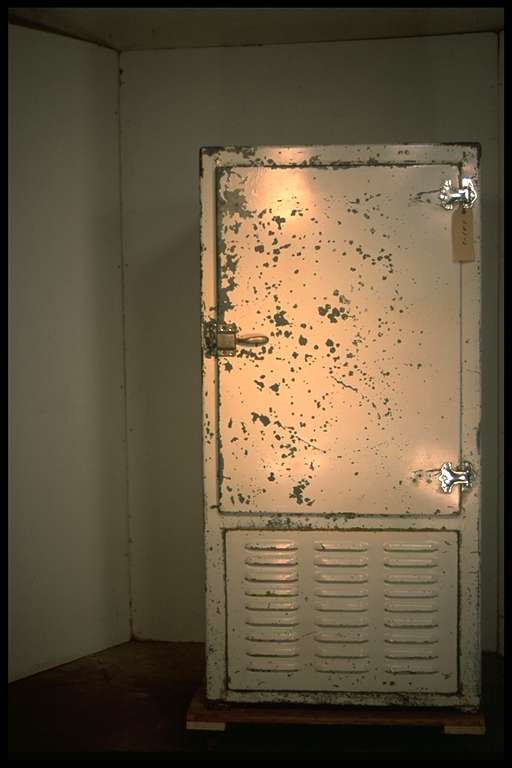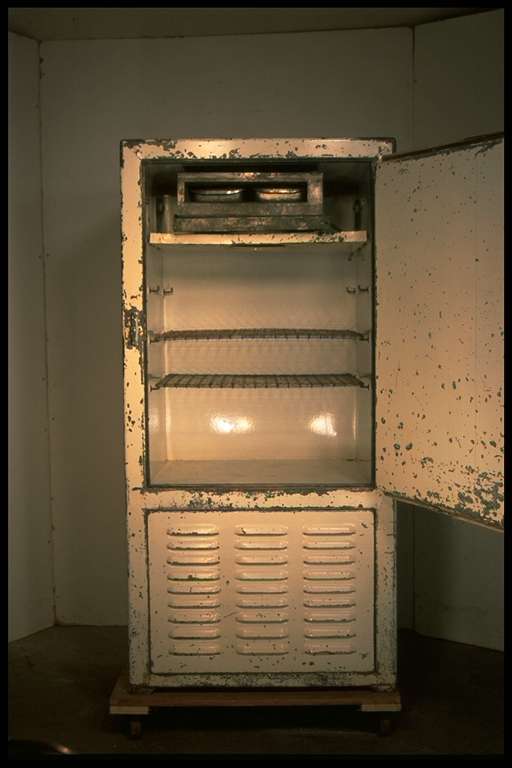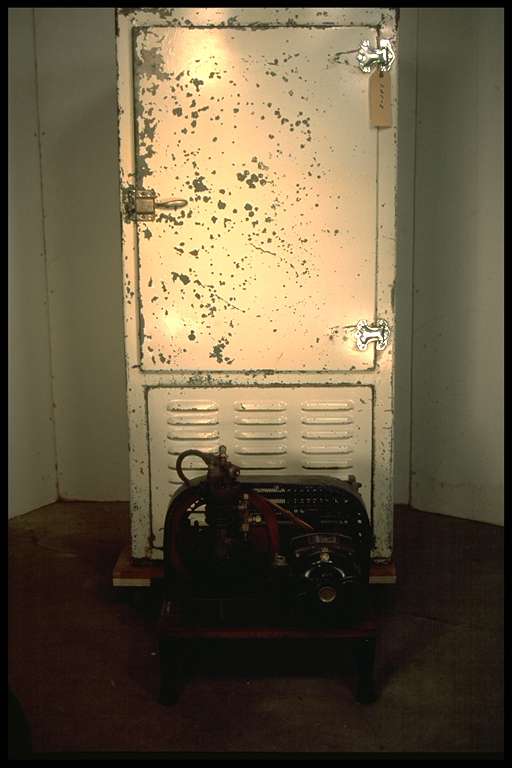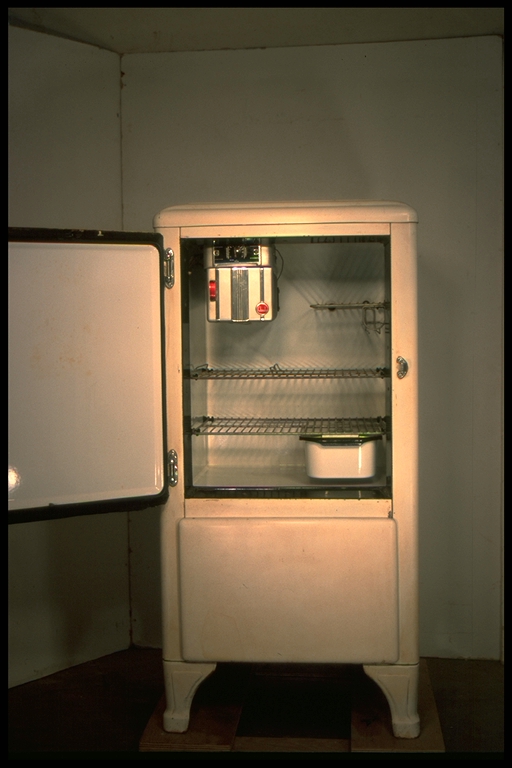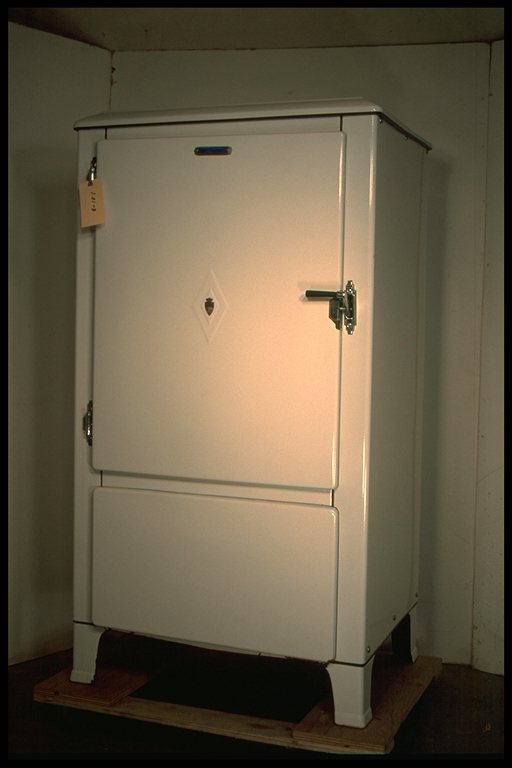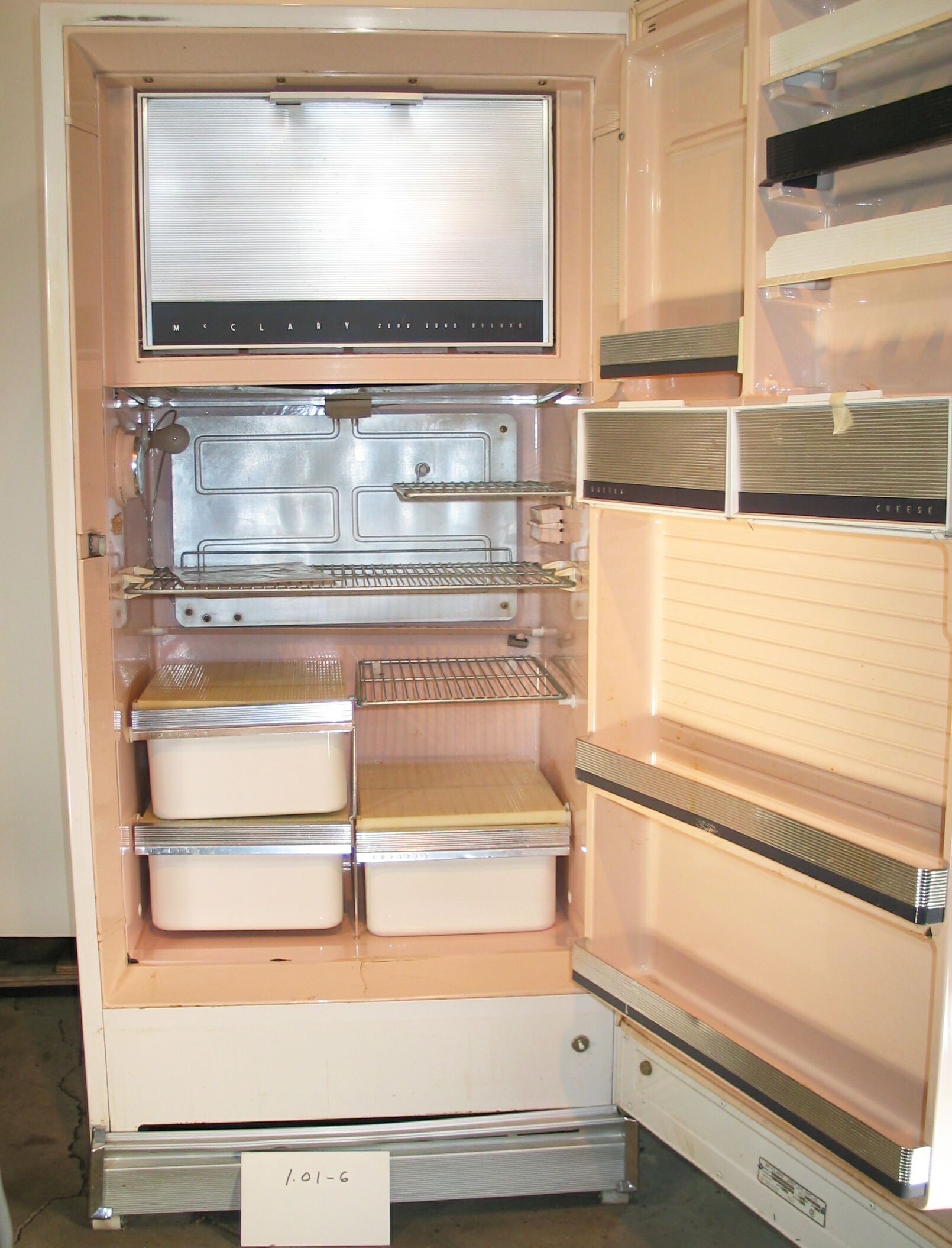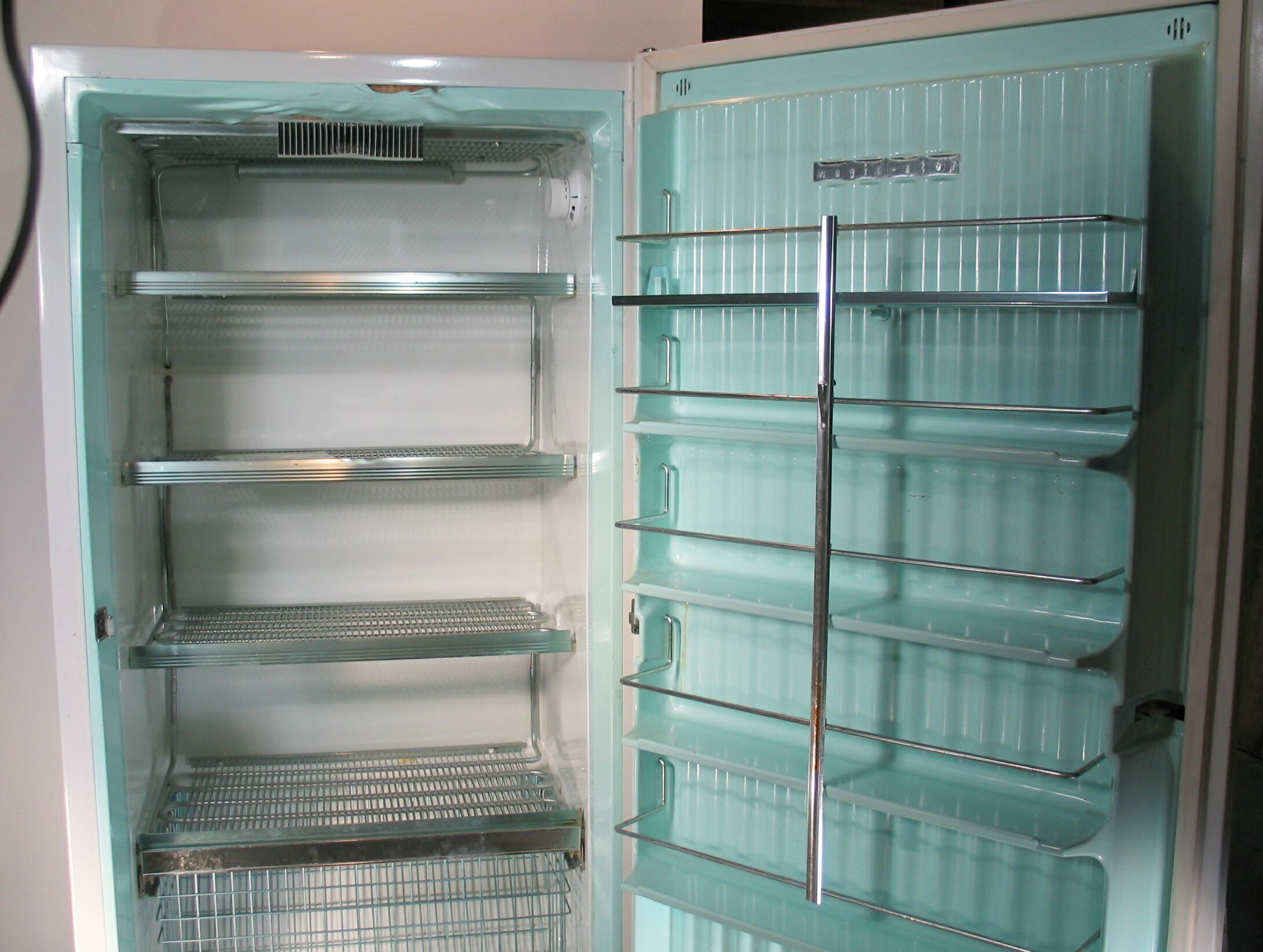1.01-2: Kelvinator 1927 Refrigerator with Remote Condensing Unit
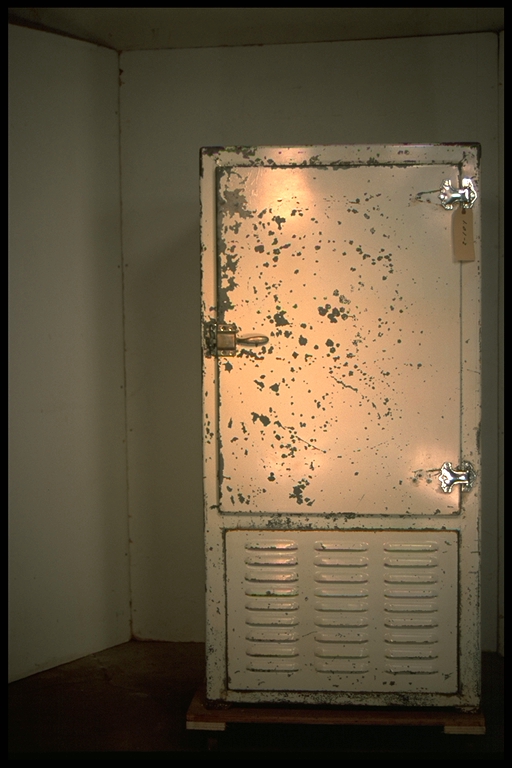
| HHCC Accession No. 2003.001 | HHCC Classification Code: 1.01-2 |
|---|
Description:
Five Cubic Foot household, Cabinet Refrigerator With Condensing Unit For Remote Mounting, Kelvinator, Circa 1926
Group:
1.01 Unitary Refrig and A/C Equipment and Systems - Household Cabinet Refrigerators
Make:
Kelvinator
Manufacturer:
Kelvinator of Canada, London Ontario
Model:
See Note #1
Serial No.:
See Note #2
Size:
26x22x54
Weight:
See Note #3
Circa:
1927
Rating:
Very rare, education, demonstration and research quality
Patent Date/Number:
First Pat. No, 1926, US, Canada and principal foreign countries, including China, with Chinese characters on name plate
Provenance:
From York County (York Region) Ontario, once a rich agricultural hinterlands, attracting early settlement in the last years of the 18th century. Located on the north slopes of the Oak Ridges Moraine, within 20 miles of Toronto, the County would also attract early ex-urban development, to be come a wealthy market place for the emerging household and consumer technologies of the early and mid 20th century. This artifact was discovered in the 1950’s in the used stock of T. H. Oliver, Refrigeration and Electric Sales and Service, Aurora, Ontario, an early worker in the field of agricultural, industrial and consumer technology.
Type and Design:
Operating system: compression refrigeration type, theoretical Carnot cycle. Design: unitary design and construction with: insulated refrigerated cabinet, evaporator and expansion valve, and self-contained refrigerant condensing unit, electric motor driven.
Air-Cooled Condensing Unit, Type: Self-contained condensing unit with belt driven compressor, single-phase electric motor, and air cooled condenser Design: early open design
Construction:
Condensing Unit: Kelvinator condensing unit, ‘bread board style’, assembled on early, wooden, plywood base in natural oiled finish, with belt driven compressor and motor (original 25 cycle motor replaced in 1948 with 60 cycle), finned forced air cooled condenser and steel tank receiver for 2.1 lb. SO2 refrigerant charge. (See Ref. 1.1, P. 82D). Condensing unit is mounted on 6 in. steel legs with natural rubber foot pads for remote (basement) installation, with 1/4 in. liquid and suction line, copper tubing with SAE flare connections. For detailed specifications see Ref. 1.1 P. 82D
Cabinet: Construction heavy galvanized brake-formed sheet stock,” gauge, wooden cabinet frame and 2 in. cork insulation. See ref 1.1, P. 79D for detailed construction
Cabinet finished in white “ Pyroxylin “ ,Original paint finish now chipping badly,
Hardware replaced with 1930’s style hinges and “ice box” style latch Evaporator: in tinned copper plate with copper tubing refrigerant coils, with inner and outer casings with 1” cork insulation, not original with this cabinet
Material:
Special Features:
This condensing unit, noisy and dirty, often with the smell of sulphur dioxide was designed for “remote” mounting in the basement of the home, to be reconnected to the refrigerator cabinet with copper tubing
Accessories:
:
Capacities:
Performance Characteristics:
Operation:
Control and Regulation:
Targeted Market Segment:
Consumer Acceptance:
Merchandising:
Market Price:
Technological Significance:
Unitary Refrigeration Equipment: The idea of a unitary piece of refrigeration or air conditioning equipment was a significant one in its own right, one that had to wait its time. The scientists, engineers and inventors in the early years of the 20th century were intrigued and obsessed with the power of the technology and of its possible market potential. What they saw was the newly discovered principles of physics and heat engines - following, for example, the early works of Carnot, Faraday, Kelvin, and the later work of Perkins, Larsen and Carrier, to name a few.
They understood the promise of the technology for the public good, not to say its consumer sales potential. Early engineering work advanced on a multiple fronts with development of compressors, heat exchangers, valves and piping variously strung together in configurations that would be found to work, but only after much experimentation.
The arrival of unitary equipment, all those parts organised into a single whole, a single unit of construction, a ‘black box’, that could be offered to the consumer market was a significant technological and cultural event. Technologically the refrigerator would need to be seen to be safe, reliable, maintainable and useful. As well, in order to attract the development capital needed, it must be seen as potentially saleable and affordable, contributing to life’s needs and desires. Its socio- cultural and economic significance was marked, for it would change much. As Canadians we would quickly come enjoy potentially healthier lives, expect new levels of comfort and convenience, with a broader, safer, more diverse and enjoyable diet.
Canadians would quickly come to think of their day differently, for the day would be defined and punctuated in different ways than ever before, as a result of the introduction of modern, electric, household appliances, of which refrigerators, freezers and room air conditioners would be a central part, by the mid 20th century
J. M Larsen produced a manually operated household refrigerator of sorts in 1913, but it was not until 1918 that the Kelvinator Company marketed the first automatic, unitary refrigerator for the home. In that year, it is reported to have sold sixty-seven machines. (See Note 1) The historic artifacts in Group 1.00, Unitary Equipment, including significant samplings the early work of Kelvinator of Canada, provide a rare view of the evolution of unitary refrigeration and air conditioning applications, as they evolved in Canada in the first half of the 20th century.
For those formative years, the artifacts in this Group, 1.00, are typical of the offerings of the Canadian refrigeration and air conditioning industry. They personified the applications found in the homes, farms and commercial premises of the period for, those that could afford life’s new amenities of comfort, convenience and privilege.
This Specimen: This refrigerator stands as a statement of the earliest, embryonic years of refrigerating technology in Canada. Showing the natural effects of ageing and constant use and repair over its 50 year, active, life span. The condensing unit is in original pristine condition with the exception of the 25 cycle motor replaced at the time of frequency conversion in Ontario in 1948, up to which point the machine had been in constant use. The evaporator is likely not original with this machine, but typical of the brine-tank evaporators used in that period. It was a period in which refrigerators were subject to high maintenance, repair over a long life span.
Industrial Significance:
This specimen tells the stories of the early years of the development of the industry in North America, where the commitment of the Industry was to the inherently noisy, mechanically troubled compression refrigeration cycle, with slow speed, often crudely machined “chunking” compressors, open motor drives and fan cooled “whirring” condensers.
The marketing of absorption systems, as an alternative, developed by Electrolux in Europe, and licensed to Servel in Evanseville Ind,. would still be several years away.
The early patent and world-wide registration marks Kelvinator as a pioneer in the field, as well as an aggressive global North American marketer. It had high expectations for industry leadership and domination.
Socio-economic Significance:
Possibly one of the earliest household, all electric, self-contained, cabinet refrigerators, coming out of a Canadian manufacturing plant, this machine would be part of the genre that would change for ever the way Canadians would think about their kitchens and the food they eat.
Patent Data: First Pat No. 1920, US, Canada, and principal foreign Countries Extensive list of patents cited, including Chinese characters on name plate, indicative of the international marketing of this product by Kelvinator.
Socio-cultural Significance:
The home of the 1920’s was not at all used to the sound of electric motors, let alone those that went on and off automatically all day and all night too. Kelvinator’s solution in a bid for customer acceptance was this machine with a condensing unit which could be tucked away in the basement out of sight and hopefully out of sound range.
The”Ice Box Styling”of the cabinet reflects the limited manufacturing methods of the day, but also the natural carryover from the age of the ice box. The electric refrigerator, then, was first imagined as an ice box and configured accordingly.
The predisposition of the industry to ice box styling, with square corners and hardware would persist for many manufacturers well through the 1930’s (see items 2 and 3). Kelvinator, however, were producing “modern” styled machines by 1934, in a bid for moving the North American mind set beyond the ice box and so to attract first time buyers.
The significance of the refigeration cabinet lies not in its presence as a restored showpiece of the early years of the industry. But rather, with its original finish, showing the effects of the many years of natural wear and tear, its significance is in its demonstrated antiquity and the many stories it tells of the years gone by.
Donor:
G. Leslie Oliver, The T. H. Oliver HVACR Collection
HHCC Storage Location:
Tracking:
Bibliographic References:
Bibliograhic Note #1 Ref. Modern Refrigeration and Air Conditioning, Althouse and Turnquist, Goodheart-Wilcox Co. Chicago, 1960
Notes:
Note #1: Kelvinator Condensing Unit Part No. 12800, Serial 2532C Note #2: Kelvinator Cabinet and part no. unmarked. Likely part of their “5 1/2 and 9 cu. ft.” series built in the early to mid 1920’s (See Ref. 1.3, P.54), similar to model 227 (See Ref. 1.1, P. 79D) Note #3: Wt condensing Unit 80 lbs, Cabinet ? lbs,
